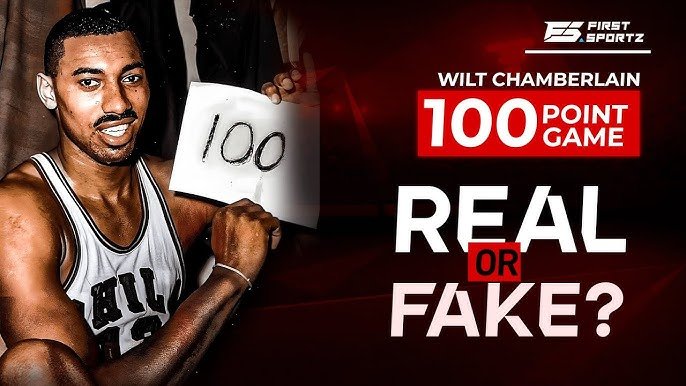For decades, Wilt Chamberlain’s 100-point game has stood as one of the most remarkable achievements in sports history. On March 2, 1962, in Hershey, Pennsylvania, Chamberlain scored an even 100 points against the New York Knicks, a record that has never been matched. But what if the entire event was carefully orchestrated? What if NBA officials, desperate for media attention and higher ticket sales, ensured that the game went exactly as planned? Shocking new claims suggest that players may have been paid off to let Chamberlain reach the milestone, raising questions about one of basketball’s most sacred records.
The circumstances surrounding the game have always been unusual. There were no television cameras to capture the full event, and only a few reporters were present. The game took place in front of a modest crowd of just over 4,000 fans—far from the packed arenas we associate with historic sports moments today. Given the lack of video evidence, much of what we know about the game is based on radio broadcasts, written reports, and firsthand accounts from players and coaches. But over time, discrepancies in these accounts have raised eyebrows.
The first major red flag is the way Chamberlain accumulated his points. In a game where teams rarely scored over 120 points, the Philadelphia Warriors put up 169. Chamberlain alone accounted for 100 of those, a number so extraordinary that it remains an outlier in NBA history. Even more suspicious is that Chamberlain, a career 51.1% free-throw shooter, made 28 of 32 attempts from the line that night—an 87.5% success rate. Many have wondered how a historically poor free-throw shooter could have such an unprecedented performance in a single game.
Former NBA players and analysts have pointed out that the Knicks’ defense seemed oddly passive as the game progressed. Some reports suggest that players were instructed not to double-team Chamberlain aggressively in the final minutes, despite knowing he was closing in on history. The Knicks, who had nothing to gain from allowing the record to happen, seemed unusually compliant. Hall of Famer Paul Arizin, Chamberlain’s teammate, later admitted that the Warriors made a conscious effort to feed Wilt every possession. But was this just strategic play, or was there a deeper plan at work?
The most explosive claim to emerge in recent years is that NBA officials may have incentivized Knicks players to let Chamberlain score more easily. Some insiders speculate that the league saw the 100-point game as a golden opportunity to boost basketball’s popularity, which was struggling in the early 1960s compared to baseball and football. By orchestrating a record-breaking performance, the NBA would have a headline-grabbing story that would generate excitement and attract more fans.
One former player, speaking anonymously years later, claimed that certain Knicks players received financial incentives to go easy on defense during the final minutes. While no concrete proof has surfaced, the unusual nature of the game lends credibility to the theory. Defenders who had been physical with Chamberlain in previous matchups appeared to back off as the record drew near, leading to a barrage of uncontested shots.
Even the Philadelphia Warriors’ coach, Frank McGuire, seemed overly fixated on ensuring Wilt reached 100. In normal circumstances, a team with a comfortable lead would slow the game down, run out the clock, and secure the win. Instead, the Warriors deliberately fouled the Knicks late in the game to get the ball back, giving Chamberlain more scoring opportunities. This highly unusual tactic raises the question: was the game’s outcome being manipulated to achieve a predetermined result?
Another piece of evidence fueling the controversy is the lack of definitive footage. Unlike other legendary sports moments that are immortalized in film, Chamberlain’s 100-point game exists only in fragmented clips and audio recordings. The only visual proof of the achievement is a famous photograph of Wilt holding up a piece of paper with “100” written on it. Given that this is considered the single greatest individual performance in NBA history, the absence of full-game footage seems suspicious. If the league truly wanted to celebrate the moment, why wasn’t more effort made to preserve it?
Adding to the mystery is the reaction of Chamberlain himself. While he often spoke proudly about the game, he also hinted at some dissatisfaction with how it was perceived. In later years, he expressed frustration that his scoring ability overshadowed his other skills, such as rebounding and passing. Some even believe he may have known that the game was, at the very least, partially orchestrated, which could explain why he didn’t always embrace it as his proudest achievement.
If the game was indeed staged, the implications are enormous. It would mean that one of the most iconic records in basketball was not achieved entirely through fair competition. It would call into question the integrity of the NBA in its early years and cast doubt on other historic performances from that era. While Chamberlain’s greatness is undeniable—his career statistics and dominance over his peers remain unmatched—this revelation would suggest that the league played a more active role in shaping narratives than previously thought.
Skeptics argue that the theory is nothing more than a conspiracy, pointing out that Chamberlain had multiple 70- and 80-point games throughout his career, proving that he was capable of such an explosion. They also note that the Knicks were already a weak defensive team and were missing their starting center, Phil Jordon, that night. But even if the game was not entirely staged, it’s hard to ignore the unusual circumstances and the possibility that external forces influenced the outcome.
Ultimately, whether or not the 100-point game was orchestrated remains a mystery. But the questions surrounding it refuse to go away, and as more details emerge, the debate will only intensify. Was Wilt Chamberlain’s legendary night truly a fair competition, or was it a carefully constructed spectacle designed to elevate the NBA? Until definitive proof emerges, basketball fans will continue to wonder if one of the sport’s greatest moments was, in fact, a well-executed illusion.





